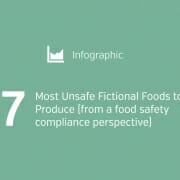Facing and Controlling Cross-Contamination in Food Processing
Cross-contamination can occur at virtually any stage in the flow of food processing, and prevention is crucial.
Understanding where and how it can happen makes prevention easier, and the four most common routes of cross-contamination are outlined below:
1. One of the main means of cross-contamination is actually the individual who handles the food.
For instance, food can become contaminated if a worker who was dealing with raw chicken earlier didn’t effectively wash his/her hands prior to handling ready-to-eat products or if they forgot to put on gloves, or perhaps they are wearing a soiled uniform.
2. Another route of cross-contamination is unclean equipment where an uncontaminated meal can come into contact with an unhygienic utensil, part of a device or maybe an unclear work area.
For instance; if the raw material receiving truck driver did not wash down their truck before carrying the materials, then there is a chance that the raw material is contaminated.
3. Cross-contamination can also occur due to direct transfer between various foods, say when a meal drips contaminated juices onto another meal. The most common example here is the storage of uncooked meat besides ready-to-eat food products.
4. Transfer of food allergens from an allergenic food to non-allergenic food is also one of the means of cross-contamination.
Mislabeling and mishandling of food products are justifications for allergen cross-contamination.
It is not too difficult to imagine a scenario where the worker who is transferring the food from the temporary storage room to the packaging area takes a detour to the processing area and unintentionally walks by the wheat production area.
Food allergies are a significant problem for individuals who have to contend with them.
Not only this, but the company might face lawsuits and gain a bad reputation due to their mishandlings of food products.
Now that we have established the most common means of cross-contamination, let’s look at the different ways by which you can successfully avoid them.
Personal Hygiene
A well-designed personal hygiene program is a must when it comes to avoiding cross-contamination.
It is highly likely that food handlers will transmit foreign material from their skin, hand, or hair without a proper hygiene program in place.
The following program will highlight different best practices in food handling such as handwashing, glove use, and hand care.
The aim is to reduce the possibility of food cross-contamination through employee awareness.
This prerequisite program should also include personal habits such as bathing, clean clothing (and the importance of a clean uniform), and the use of hair and beard nets at all times.
The health of employees is another factor that influences cross-contamination.
An unwell employee should be removed from any area where there is a moderate likelihood of food or related ingredients becoming infected.
It is important to know if employees are healthy or if they have any disease or illness that could contaminate your food product.
Therefore, regular inspection and medical screening prior to employment should be conducted and a record of illness and injury should also be maintained.
Workers’ hands must be washed thoroughly and every so often while handling the food.
For instance, after handling raw meat, seafood or after using the restroom, they must remember to wash their hands, and after washing their hands it is vital to ensure that they are dried properly by using paper towels.
Finally, they should sanitize their hands prior to returning to work.
Each year, millions of foodborne illness cases occur all over the world.
Therefore, it is critical that all involved parties focus on ensuring safe food handling.
Employee training is key as it will encourage them to follow everyday sanitation rules and thereby reduce the chance of people becoming ill due to cross-contamination.
The training should include basic food safety practices such as personal cleanliness and good sanitation practices to prevent food product contamination.
Posters demonstrating best practices can be displayed where possible as additional support to the training.
Color Coding
The most straightforward way to put a stop to contamination and distinguish between workstations is color coding.
It is a well-known fact that the tools used for raw meat should not touch the end product.
This helps to control the risk of pathogens such as Listeria Monocytogenes, E. Coli, Salmonella and so on (Learn more about pathogens in our datasheet library).
Another advantage of changing tools for different processes is to control cross-contamination of common allergens.
In both cases, if a food manufacturing facility uses color coding to distinguish between the tools and equipment it will help to mitigate cross-contamination and support the facilities with maintaining Good Manufacturing Practices.
Identification of appropriate areas for storage, cleaning, and sanitization is also much easier with color coding tools and locations.
Occasionally, food processing facilities use unique color coding.
Food facilities can determine the colors which best suit the company’s objectives, processes, product types, and facility design.
For example, a peanut processor may select white for direct contact while a processor of milk powder might choose a different color such as green or red.
The color coding system will only work if it is properly communicated to the employees.
Clear guidance should be provided to the employees outlining the importance of the program and exactly how it should function.
The procedure should also explain the steps to take in the event of a nonconformance.
Process Flow
A cross-contamination prevention plan should also consider how the process moves across the company.
From the starting point, i.e., the receipt of the raw material, to the finished product, the process should be evaluated to understand how ingredients come into the facility and how they will be processed.
This will help to determine the crossing of product and probable points of cross-contamination.
The solution to prevent cross-contamination could be to move products in sealed packages/containers and confirm that no leakage is present.
If it is not possible or allergens are of concern, then sanitization of the area is the key.
It is also a good practice to complete the production of non-allergenic foods first and then allergens at the end of the day.
The production line should be sanitized following the last batch.
Where this is not possible, sanitization processes need to be in place in between the change of production.
Cleaning
Cross-contamination will occur if the food product comes into contact with insufficiently cleaned surfaces such as equipment, clothes, and utensils.
The efficiency of cleaning must be inspected on a regular basis and the cleaning policies should outline the systematic procedure, i.e., high-risk areas should be cleaned first.
The most dangerous source of microorganisms in a food production facility are the floor or drain.
Cleaning and sanitization of floors and drains should be repeated at the end of each production day along with precautionary measures for the duration of production to minimize the microbial growth and food safety risk.
Cross-contamination between different plant areas can be managed by using the methodical sanitation program, which you can read more about in the Validation of Cleaning Programs whitepaper.
Ahead of using cleaning chemicals and sanitizers, it is of the utmost importance that employees read and understand labels and the material safety data sheet as well as understand how to use the appropriate personal protective equipment.
They should also understand how to use signs, adhere to procedures, and be careful while moving on the wet floor.
Cleaning is not only limited to food contact surfaces; as mentioned previously in this article, clothes are a known source of cross-contamination.
Bacteria or food particles can be transported from one place to another by means of dirty clothing and in order to stop this, clothes should be changed when moving from one production area to another.
This is especially crucial while working with high-risk foods or allergens.
A plan to eliminate cross-contamination can be put together by combining all of these different pieces. However, it still does not mean that nothing will go wrong during daily production.
The strategy of cross-contamination prevention needs to be reviewed periodically, and it may be wise to consider doing so on at least an annual basis.
The food facility will need to change its approach every time a substantial change occurs, i.e., if a new product is developed or supplier is changed.
A thorough plan that is rigorously enforced will help identify and tackle any weaknesses in the process flow, containing and resolving issues within the facility and preventing cross-contaminated products from reaching consumers.












Very good article.
I would like to know whether processing of meat and fish in the same facility using same equipment and staff but one product at a time is possible or not. That means when meat processing is going on, fish processing is not allowed.Is it legally allowed?
Thank you for your comments. The legitimacy of the scenario you mentioned will depend upon the legislation you follow. I personally would recommend using two separate production lines for fish and meat. If the same equipment and staff have to be used then a rigorous food safety system needs to be developed, such as intense cleaning after each product processing followed by validation by swab testing for allergen and species cross-contamination. The staff should be properly trained and preferably provided with colour-coded workwear to avoid the risk of contamination. The final products will require to be labelled regarding possible allergen, i.e., Fish. Again, this is just a suggestion and you will need to refer to the legislation in order to avoid any regulatory concerns.
Dear Sanika ,
we want to use one line to be able to processes cooked fish and uncooked fish.
If we plan our processing cooked fish first day 1 , no raw fish . All with separate colour coded utensils (red) , separate overalls, separate high risk work procedures. After processing wash down sanitize , validate
next day change all utensils to blue , overalls and work procedure so as to process raw
fish
After processing , wash down sanitize swab ready for next week cook production.
Isthis possible